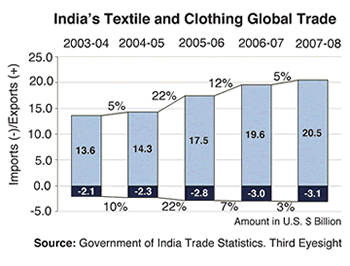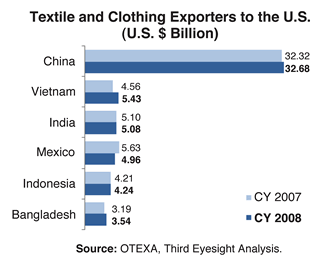 Chandni Jain
Chandni Jain
 Devangshu Dutta
Devangshu Dutta
Chief Executive,
Third Eyesight,
and Managing
Partner, PVC Partners
Chandni Jain and Devangshu Dutta work with Third Eyesight, a specialist management consulting firm focused on retail and consumer products. Third Eyesight provides strategy and operational support to international companies looking to improve their product development and sourcing from India or wishing to explore the Indian market.
India’s traditional skills in fabrics, spinning capacities, intricate handwork, and creativity in producing a range of design-intensive products have enticed buyers from all over the world. India has a recorded history of global trade in textiles dating back several thousand years and was once the largest global supplier.
The textile sector in India was suppressed during its years as a colony and then remained constrained by capacity licensing restrictions. In 1962, just as India’s exports had begun to grow, quota restrictions closed the gates to free trade, nipping India’s exports in the bud. Preferential trade arrangements placed further constraints, as both the U.S. and the E.U. provided duty-free and quota-free access to some countries. On the other hand, China leap-frogged into the lead position, first as the factory for Hong Kong and Taiwanese industry and then for the rest of the world.

However, in the last couple of decades, the Indian industry has enriched its manufacturing capabilities and diversified its product base, emerging once again as an important global player. With a current market share of just over three percent, India retains a strong and sustainable position among the top five exporters of textiles and clothing in the world. Given the current market share positions, it is unrealistic to expect India to catch up with China any time soon. However, the trend clearly is towards a reintegration of India’s industry with the global trade.
The United States is the largest destination country for Indian textile and clothing exports, while the European Union bloc is the largest regional market for Indian exports. Together the two markets account for 75 percent of India’s clothing exports.
Indian exporters are also actively working to diversify into other markets such as Brazil, South Africa, Japan, Russia, and Australia. India has some advantages in its favor, including a perception and
mind-share attitude that is better today than it was 10 to 15 years ago.

India’s Key Strength: Product Development
Among the top five low-labor-cost clothing suppliers (China, Turkey, Mexico, India, and Bangladesh), only China and India do not have preferential access to their major markets and yet compete very effectively on the basis of their inherent strengths. India is one of the few countries in the world that offers
Among the workforce, the existing needlecraft skill base has enabled the Indian industry to retain its position as one of the key suppliers of apparel and
textiles and to add new products to its portfolio by rapidly learning new techniques.
According to Dr. William Fung (managing director of Li & Fung), India shows high product differentiation and development skills that make it a logical place for buyers to invest time and energy. The frenetic rate of new sampling that goes on every season in factories around India demonstrates this orientation to new product development.
In addition, Indian industry has been flexible in terms of production quantity and lead time. Indian manufacturers present the possibility of producing quantities as low as a few hundred pieces. This capability is especially critical in an unpredictable market where retailers and brands are looking to source ever-smaller quantities of product, increasingly closer to the season.
Growth of the organized branded market within India and the entry of international brands (the customers for India’s exporters) have also given exporters and brands a common ground to work on.
Moreover, India’s size as a potential market is an important factor in its role as a sourcing hub, and many companies are now looking to grow their sourcing base in and around India as a precursor to selling within the Indian market. For instance, Mark Ashman, the chief executive of British retailer Marks & Spencer’s Indian business has said that the company intends to source 70 percent of its products from India over the next five years, up from the current 20 percent.However, There Are Challenges
India has many of the ingredients in place to own a larger share of the global market, but there are also challenges to be aware of.
A major issue is the dominance of small companies, which brings with it the problem of lower productivity. While skilled Indian labor is inexpensive in absolute terms, much of this advantage is lost due to the lower productivity levels of small firms. Even though the government policies that created this distortion have gradually been removed, their impact is still visible.
Moreover, while synthetic fibers comprise about half of the global textile market, the Indian synthetic textile industry is not as well entrenched as competing supply countries in the Far East.
Finally, India faces a global logistics disadvantage due to its geographic location. Unlike its competitors Mexico (for the U.S.), Turkey (for the E.U.), and China (for Japan and the U.S. West Coast), India is distant from all the major markets. Therefore, the cost of shipping is higher, and shipping time adds to the disadvantage. Cost of shipping is also affected by the fact that inbound freight traffic has been low, and container movement is not at its most cost-efficient. However, this is improving, as India is increasing its imports from other countries.
In recent years the government’s textile policy has also helped in reducing impediments for the industry. The government has removed foreign investment restrictions from textile and apparel manufacturing and has also brought down import duties on capital equipment, creating grounds for foreign investors to set up manufacturing plants competitively in India.
However, a few areas of policy weakness stand out. The current labor laws are still a disincentive in scaling up for Indian firms, while customs clearance and port operations also need to be further streamlined.
Looking Ahead
During our work with major international retailers in the area of global sourcing strategy in the last few years, the issue of supply base diversification has come up several times whenever there has been a hurdle or barrier to cross with China (quotas, SARS, etc.). Among the countries that come up strongly in the analysis, India is frequently at the top of the list. The potential that India offers as a sustainable and strategic supply base cannot be ignored, but the biggest challenge to tackle is buyer inertia and past perceptions. For many buyers, India seems to become important when the so-called “India look” is in fashion and drops when the look is over.
So our single point of advice to retailers, brands, and importers would be to “go beyond the obvious.” Whether you have sourced from India previously or not, do not limit yourself to your past perceptions of what the Indian supply base can produce. Is your sourcing still restricted to beaded, sequined, and tie-dyed blouses? Without a doubt, India does very well in producing these products. However, there are now Japanese companies sourcing men’s tailored suits, German brands sourcing women’s undergarments, department stores buying work-wear and formal shirts, and young fashion brands buying funky denim and jersey wear out of India. Prompt vendors to show you something new in terms of product type, fabric developments, etc. during each meeting.
Further, the structure of the Indian vendor base will certainly offer you the possibility of flexible and small production runs, and the possibility of experimenting with new products. For instance, the supply chain director of a large European mail order company feels that there is an opportunity to do quick-response sourcing, in effect “doing a ‘Turkey’ out of India.” He feels that Indian vendors should be positioned as “the best in service, quality, and speed of response.” He adds, that India’s business leaders have an advantage, being ”English-speaking and international in nature,” which can help to grow business in India more easily.
So, take a new look at India and, most likely, India will become more important in your sourcing decisions — whether in terms of product development or to explore additional margin opportunity.